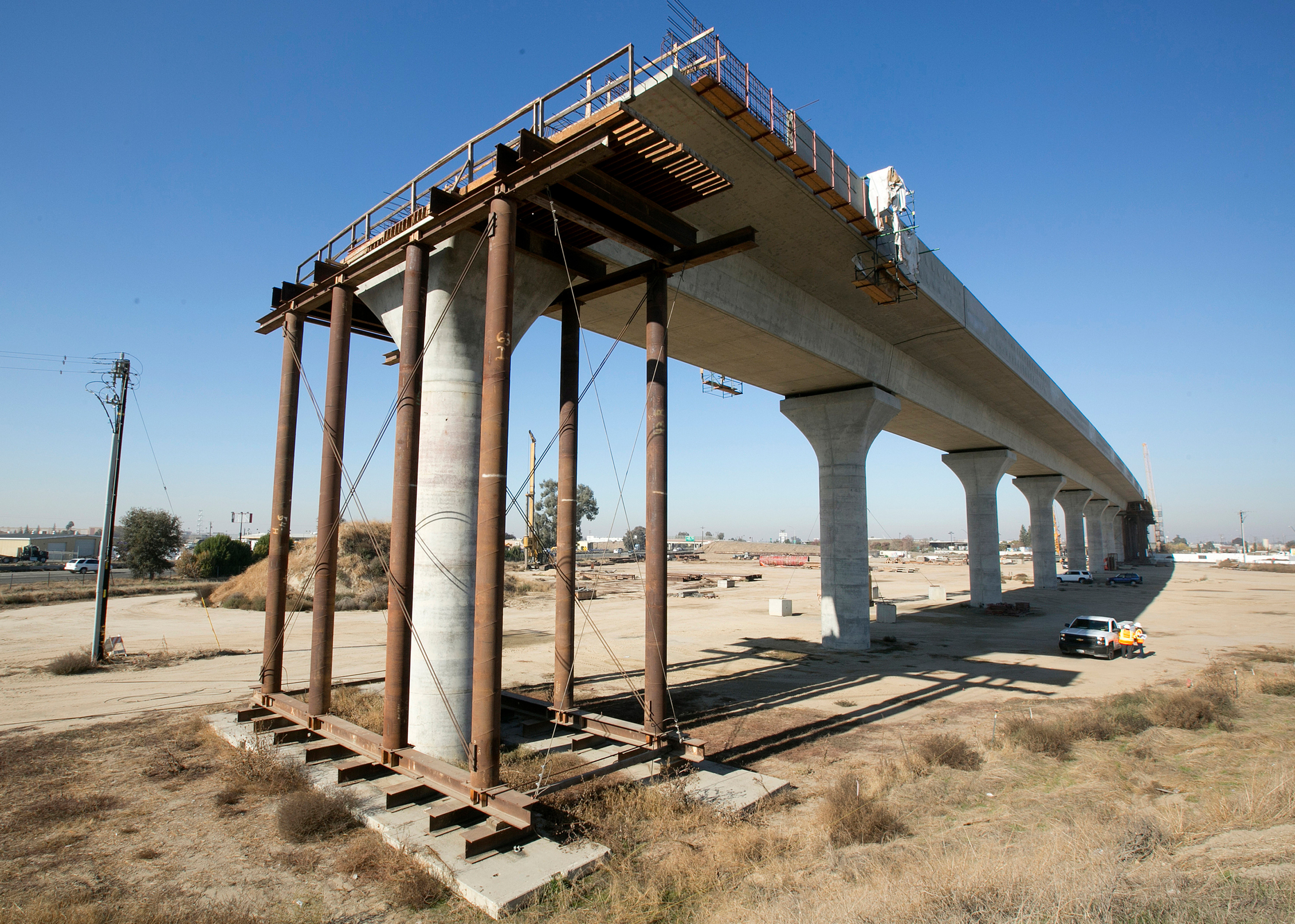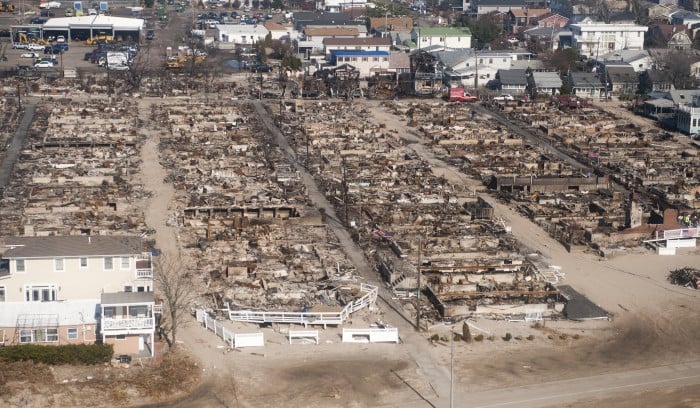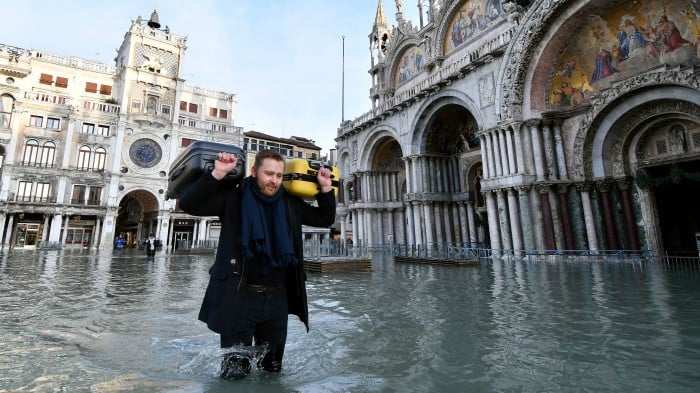Climate change means the US must start building big things again
Sorry if it blocks your views.

Sixteen years ago, I wrote about the early challenges surrounding the development of the Transbay Transit Center, slated to become the northern terminus of a long-sought high-speed rail line connecting San Francisco to Los Angeles.
The bullet train promised to ease commutes, cut greenhouse-gas emissions, and tie together the state’s far-flung economic hubs. California established a state agency to begin planning the more than 500-mile (800-kilometer) railway back in 1996. Voters approved bonds for it in 2008, and construction has moved ahead on various legs of the development.
But along the way, it fell a decade behind schedule while the budget swelled by tens of billions of dollars. Last February, the Trump administration yanked a key piece of federal funding, halting new work from moving forward. The fate of the roughly $80 billion project, after more than two decades of planning, is now in doubt.
What’s striking, however, is how unexceptional this dawdling is. Nearly every giant infrastructure project suffers from massive delays and cost overruns, when they aren’t shut down altogether. The US has become terrible at building big things, and negligent in even maintaining our existing infrastructure.
Major portions of the nation’s highways, bridges, water pipes, ports, railways, and electric transmission lines were constructed more than half a century ago, and in many cases they are falling apart. The American Society of Civil Engineers has estimated a $1.4 trillion gap between the funding available and the amount needed to maintain, rebuild, or develop US infrastructure between 2016 and 2025. That figure swells to $5 trillion through 2040.
That all bodes terribly for our ability to grapple with the coming dangers of climate change, because it is fundamentally an infrastructure problem. Reducing US greenhouse-gas emissions in line with global efforts to prevent 2 ˚C of warming will require annual investments in clean technologies like renewables and a modern grid to increase tenfold by 2030, from $100 billion to $1 trillion, according to a 2015 study by the Deep Decarbonization Pathways Project.
To prepare for the climate dangers we now can’t avoid, we’ll also need to bolster coastal protections, reengineer waste and water systems, reinforce our transportation infrastructure, and relocate homes and businesses away from expanding flood and fire zones. Depending on how rapidly or slowly the world cuts emissions, climate adaptation costs could run tens or hundreds of billions of dollars per year by midcentury, according to the latest National Climate Assessment.
Given those staggering costs and tight time lines, we can’t afford to take decades to build—much less not build—a single project.
“As things stand today, we are going to use up the world’s remaining carbon budget in the time it takes California to conduct the ‘environmental review’ of a new train line,” says Gabriel Metcalf, author of Democratic by Design and the former head of the San Francisco Bay Area Planning and Urban Research Association.
‘It’s everything’
Our aging infrastructure is already failing to protect us from extreme events that climate change very likely amplified. In 2012, Superstorm Sandy unleashed storm surges that breached the shores of New York City, swamping subways, knocking out electricity, and killing dozens of people. The tragedy set off an ongoing debate over the need for storm barriers, seawalls, or other protective measures.

In California, where the fierce fall winds now increasingly arrive before the seasonal rains, downed electricity transmission wires have sparked some of the deadliest and most destructive fires in the state’s history.
A recent state report found that the utility PG&E’s crews hadn’t climbed a transmission tower near Pulga, California, to inspect it since 2001, even though it was 97 years old and decades past its “useful life.” On a blustery November morning in 2018, a C-hook failed and a wire broke free. Minutes later, a PG&E worker reported the first signs of the brush fire that would nearly destroy the town of Paradise and kill 85 people.
When I asked Costa Samaras, director of Carnegie Mellon’s Center for Engineering and Resilience for Climate Adaptation, what parts of our infrastructure we need to renovate or rebuild for coming climate dangers, he recited a list: “Water systems, power systems, stormwater systems, reservoirs, dams, pipelines, airports, train tracks. It’s everything.”
And we’re not talking about small repairs. Upgrading the nation’s drinking water, wastewater treatment, and stormwater systems will cost more than $600 billion in the coming decades.
For example, a huge share of the nation’s storm drains were designed on the basis of rainfall data that predates the 1960s. In 2018, CMU doctoral student Tania Lopez-Cantu dug through the Department of Transportation design manuals for dozens of states, along with NOAA weather data, and found that rainfall levels have significantly increased in recent decades in about 70% of the areas where information was available. That means that in many regions, particularly the Upper Midwest, the East Coast, and the Gulf Coast, the pipes are often too narrow for current precipitation patterns, to say nothing of the storms expected in the coming decades.
As it stands, about $1 trillion in coastal real estate is exposed to rising sea levels and increasingly severe storms, floods, and erosion, the National Climate Assessment found. Some 60,000 miles (97,000 kilometers) of roads and bridges already run across vulnerable coastal floodplains.
Vehicles cross bridges rated as “structurally deficient” two million times each day in the US, where the average structure is more than 40 years old. Thousands will become vulnerable to climate change by midcentury, as higher and faster rivers carry away the sand and gravel supporting foundations, requiring more than $1 billion in annual maintenance efforts.
Some areas will simply cost too much to save. A recent analysis of the Florida Keys found that raising a three-mile section of road enough to avoid likely flooding levels in 2060 would cost more than $180 million, an impossible price tag to protect the two dozen or so homes that line it.
Globally, the world will need to spend about $90 trillion within 15 years to replace aging infrastructure in wealthy nations and build new systems in emerging economies, according to a 2016 study by the Global Commission on the Economy and Climate.
Designed to be slow
Nations certainly can build rapidly when they decide to.
China has installed 15,500 miles (25,000 kilometers) of high-speed rail lines since 2008, more than the entire rest of the world. At the same time, it’s been crisscrossing the nation with dozens of ultra-high-voltage transmission lines, which will stretch nearly 23,000 miles (37,000 kilometers).
Various proposals to build such next-generation lines in the US, which would make it far easier to balance fluctuating wind and solar sources across time zones, have been bogged down in multi-jurisdictional political and legal battles for years.
I got an up-close glimpse of the forces that impede development when I used to cover real estate and planning in the San Francisco Bay Area. Every apartment building, condo project, or office tower took years to get approved, if it could at all, as long lines of concerned citizens and interested parties queued up to speak at public meetings.
NIMBYs rejected any building that threatened to obscure a view, throw a shadow onto their street, or make it harder to find a parking spot. They wielded well-intentioned environmental rules as weapons to slow or kill proposals. Political consultants, unions, and community groups all knew how to slow the process down or speed it up, depending on whether their concerns, or contract terms, were satisfied.
But there are broader challenges as well. Citizens vote down tax increases or bond measures necessary to build infrastructure or maintain it properly. Zoning laws, housing prices, federal insurance policies, and the need for rising tax bases all further distort planning decisions, pushing construction into dangerous areas and encouraging unsustainable development patterns.
“Our legal system was designed to be slow because we want the government to take measured, considered action,” says A.R. Siders, an assistant professor focused on climate adaptation policy at the University of Delaware. “The problem now is, how do you match up a slow process with rapid change?”
Ignoring warnings
Far from preparing for the coming dangers, we’re too often rebuilding in largely the same way, even in the aftermath of floods, fires, and other disasters—ignoring warnings that couldn’t have announced themselves more clearly.
Between 2010 and 2017, developers built 4,500 homes worth nearly $5 billion in coastal areas of New Jersey that will be at risk of flooding once a decade by 2050, according to a Climate Central study. And much of it was reconstruction following Sandy.

This past summer, I drove to Paradise, California, to talk to residents and officials about the efforts to rebuild the town in the aftermath of the fire.
Town officials had spent months working with a disaster recovery firm that recommended a series of safety measures exceeding state standards, including banning wood fences that run up to the home, eliminating most gutters that allow vegetation to pile up, and requiring sprinklers for all types of homes.
But during a town council meeting that night, a number of residents stood up to argue against the measures, saying they’d make it too expensive to rebuild or would diminish the town’s charm.
“We like the look of the town,” one man said, as I noted in an earlier story. “It’s forested, it’s shaded, it’s green, it’s beautiful. We are willing to accept some risks.”
Town officials rejected 11, weakened five, and approved only four of the proposed standards.
A sustainable public works boom
The times in the past when we’ve built a lot of infrastructure quickly have been when the federal government stepped in, pouring vast sums of money into big projects with a common goal. In the case of FDR’s New Deal and Obama’s 2009 stimulus bill, the aim was getting the economy back on track, creating a sense of urgency behind funding and building ambitious projects.
Billy Fleming, research director of the Ian McHarg Center at the University of Pennsylvania, has argued that the best opportunity in this era may lie in the Green New Deal, the sweeping proposal to slash emissions and fortify cities against climate change. He writes that it could pick up where the original New Deal left off, revitalizing “an activist federal design bureaucracy” and marshaling a huge pool of federal funds for climate-focused projects.
The amalgam of federal agencies set up in the 1930s put millions of Americans to work building hundreds of thousands of miles of roads, and tens of thousands of dams, parks, libraries, schools, and other projects. The Tennessee Valley Authority alone built more than a dozen hydroelectric power plants and installed thousands of miles of transmission lines, helping to dramatically boost the share of rural homes with electricity.

If we allocated funding and streamlined approvals for clean energy and climate adaptation projects—through the Green New Deal or some other legislation—perhaps we could spark a modern, sustainable public works boom. We could put people to work building smart grids, wind farms, solar plants, EV charging stations, mass-transit lines, high-speed rail, and more.
Unfortunately, we’re not likely to move forward on major infrastructure initiatives without broader shifts in political power and a public perception that addressing climate dangers is an urgent need. Once that happens, we’ll need to strive to protect social equity, limit environmental damage, and seek input from vulnerable communities, areas where earlier public works projects often fell short.
A new notion of public input
But what we can’t do is allow the public input process to continue being used as a form of “predatory delay” that simply protects existing wealth and the status quo, says Metcalf, now chief executive of the Committee for Sydney, an urban policy think tank.
We need more public input in the early stages, as we determine how to delegate authority to federal agencies, but less at the individual project level, he says: “If we want to deliver the infrastructure of climate adaptation more quickly, I think we should admit that it will require a different notion of public input and radically shortened time lines.”
In other words, constructing a massive amount of new infrastructure that achieves a cohesive set of national goals is impossible if we simply allow cities and citizens to prioritize their individual concerns.

We’ll need to construct seawalls that save many homes and buildings, even if they do lower property values. We’ll need to build massive coastal wind farms, even if they do spoil some seaside views.
We’ll need to string transmission lines across public and private lands. We’ll need to dig up city streets and sidewalks to fix subways and sewer lines. We’ll need to relocate some neighborhoods and towns altogether.
And yes, we’ll need to raise taxes to fund the huge amount of work to come.
Deep Dive
Climate change and energy
The problem with plug-in hybrids? Their drivers.
Plug-in hybrids are often sold as a transition to EVs, but new data from Europe shows we’re still underestimating the emissions they produce.
Harvard has halted its long-planned atmospheric geoengineering experiment
The decision follows years of controversy and the departure of one of the program’s key researchers.
Why hydrogen is losing the race to power cleaner cars
Batteries are dominating zero-emissions vehicles, and the fuel has better uses elsewhere.
Decarbonizing production of energy is a quick win
Clean technologies, including carbon management platforms, enable the global energy industry to play a crucial role in the transition to net zero.
Stay connected
Get the latest updates from
MIT Technology Review
Discover special offers, top stories, upcoming events, and more.